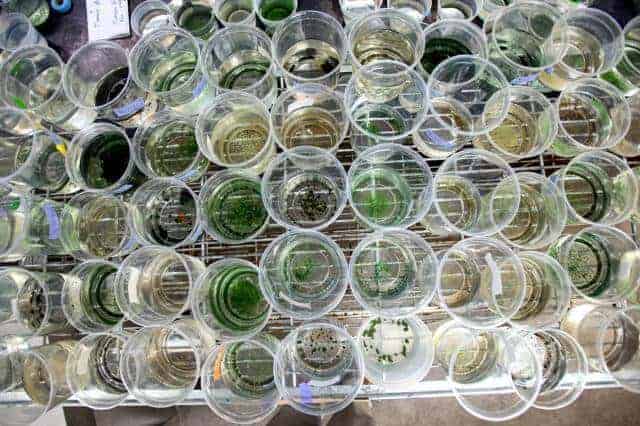Most animals, including humans, have two copies of their genome—the full set of instructions needed to make every cell, tissue, and organ in the body.
But some animals carry more than two complete sets of the genome, referred to as polyploidy. Biologists have long wondered whether these extra chromosomes help or hinder those species.
In a study involving multiple generations of a freshwater snail in New Zealand, researchers at the University of Iowa found that polyploidy appears to be neither an asset nor a drawback for females bearing offspring without the help of a male. Instead, it’s the snails’ sexuality that creates an advantage: Asexual females, the study found, grew twice as fast during the late juvenile phase and reached reproductive maturity 30 percent faster than female snails that mated with males.
That in itself raises fundamental biological questions: If asexual females grow faster and bear children much more quickly than sexual females, what’s the purpose of sex, and why is it the dominant method of reproduction in the animal world?
“When we did the study, we thought polyploidy would be bad for asexuals, but we didn’t find any evidence of that,” says Maurine Neiman, associate professor of biology at the UI and corresponding author on the paper, published in the journal Ecology and Evolution. “This is making the role of sex even harder to explain.”
The mud snails, Potamopyrgus antipodarum, live in lakes and streams all over New Zealand. They were also discovered in Idaho in 1987 and have since spread to the Great Lakes and farther east to Chesapeake Bay, according to the U.S. Department of Agriculture, which classifies the animals as an invasive species.
Sexual and asexual females are known to live in the same lakes in New Zealand, although they also exist separately in other lakes. Males will mate with either, but their genes are not passed on in encounters with asexual females. Those factors, and the snails’ abundance, made them a good species in which to test the effects of polyploidy.
The UI team compared sexually reproductive female snails with only two copies of their genome to asexual females carrying three and four copies. Together, they produced enough generations to occupy 1,500 cups—one cup per snail.
“When we began, we thought the project would take six to nine months,” says Katelyn Larkin, who earned her bachelor’s and master’s degrees in biology at the UI and has worked in Neiman’s lab since she was a sophomore. “Instead, it took more than three years. We learned that these snails grow at a snail’s pace.”
The asexual females, regardless of the number of genomic copies they possessed, grew faster and reached reproductive maturity quicker than the sexual females, the researchers discovered. In human terms, it’d be as if the asexual females could produce children at 13 years of age, whereas the sexual females wouldn’t reach reproductive age until age 18. Couple that with the fact that asexual females produce only female offspring, and you wonder why sexual female snails still exist.
“It’s not only that (the asexuals) are not making males. The asexual daughters are growing up faster too,” Neiman notes.
Before her study, Neiman thought the asexual females would bear extra costs for each additional genome because they would be chock full of metabolically expensive ingredients like RNA and proteins. Such is the case with plants, like wheat. But there was no difference in growth rate, shell length, or time to reproductive maturity between asexual females with three genomic copies and those with four, ruling out that theory.
Instead, the surprise lay in the fact the asexual females didn’t seem to pay any price whatsoever for having those extra genomes. In fact, there was no discernible disadvantage at all.
So, why do sexual female snails exist, and how do they survive when they’re co-existing and competing with asexual females?
The answer may lie in part to a parasitic worm that preys upon the snails. The asexual females are more vulnerable because their offspring’s genomes are exact replicas of their own, making them easier to target and wipe out. The sexual females, because they mate, inherit a separate, distinct genomic set that diversifies the gene pool and thus makes them better able to withstand parasitic attacks.
Still, sexual females have been found alongside asexuals in lakes without the parasitic worms, which muddies the whole idea that genetic diversity is the sole reason why sexual snails persist.
Neiman seems to like it that way.
“You could argue that our genome is the most important thing we have, yet we don’t know why humans have two copies when a lot of organisms do fine with one, or three, or more,” she says. “This research speaks to that question.”
Claire Tucci, who is pursuing a master’s in biology at the UI and began working on the experiment as an undergraduate, is the other author on the paper.
The U.S. National Science Foundation and the Research Council of Norway funded Neiman’s work; Larkin and Tucci obtained funding from the NSF and the Iowa Center for Research for Undergraduates.
If our reporting has informed or inspired you, please consider making a donation. Every contribution, no matter the size, empowers us to continue delivering accurate, engaging, and trustworthy science and medical news. Independent journalism requires time, effort, and resources—your support ensures we can keep uncovering the stories that matter most to you.
Join us in making knowledge accessible and impactful. Thank you for standing with us!

